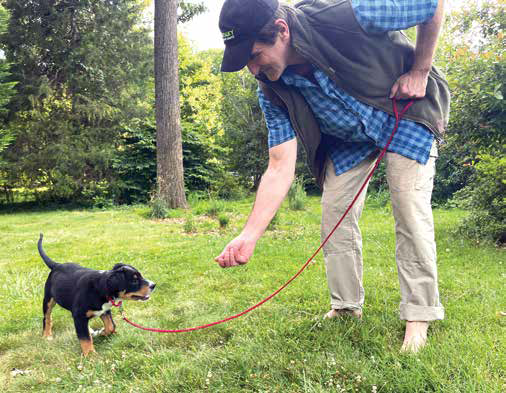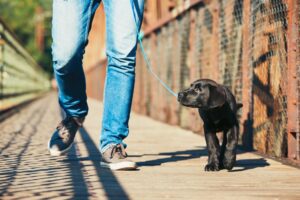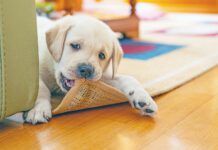
You just brought your new puppy home and you can’t wait to head out on that first walk. You’ve been picturing this happy moment forever. You pop on the leash, swing open the door and . . . your puppy won’t move. Huh.
So you pull her a little, thinking she just has to get into the swing of things. But now she’s flat-out refusing. She has planted herself. Elbows locked.
Weird.
When you try again later, she gets a whole 10 feet down the walkway before the brakes come on. You pick her up and try carrying her a bit. When you set her down, she’ll walk all right – straight back to the house, desperately straining the whole way.
If you’re like most folks, you’re mystified – and a little disappointed. After all, aren’t dogs supposed to like walks more than anything else?
SENSIBLE SELF-PRESERVATION
The truth is, it makes total sense when a puppy is hesitant to head out on a leash with her new owner. As stunned as you are at this turn of events, look at it from the puppy’s perspective:
- This first week, your new pup is suddenly in a completely new environment without the canine family she’s always known.
- Previously, any new experience took place surrounded by littermates, but she has to process this leash-and-walk thing all alone.
- This may be her first day wearing a collar – a strange thing snug around her neck.
- This may be her first moment with a leash attached to that collar, adding pressure that might make her feel trapped. (Just because we humans are used to seeing dogs on leash does not mean it is natural for them!)
- It’s possible that her only prior outdoor time has been the same yard every time. As you open the door, she is overwhelmed by completely new smells, sounds, and sights. Maybe she’s never gone down steps before, or heard a car, or seen a kid on a bike. She needs to process all of that at her pace.
- As nice as you are, remember you’re still a relative stranger to your puppy, so your presence may not yet be very reassuring.
So, it’s not shocking when a new puppy hates her first walk. In fact, it’s surprising when she likes it – and it likely means she had a good breeder or foster home where somebody took the time to introduce things beautifully! But never fear. Follow these steps and you’ll be happily walking together soon.
SLOW DOWN WHEN LEASH TRAINING YOUR DOG
The key is simple: Use your own empathy as a guide, and break this overwhelming experience into smaller, digestible pieces:
- Spend the first afternoon with just a light little collar on the pup (not a wide leather collar with a heavy buckle). Distract the pup with fun toys and play so she doesn’t just sit around thinking about how itchy, strange, or distracting that collar is. It may take minutes, hours, or days to get used to.
- To create positive feelings about the collar, give the pup special treats (such as a morsel of turkey or cheese) whenever you put her collar on.
- When she’s okay with a collar, start attaching a light kitty leash she can drag around inside for five minutes at a time. (And, again, give her a treat every time.) The pup may try to bite the leash. Keep up some fun distractions to minimize that. The goal is to see from the pup’s body language that she’s not freaked out by the feeling of the leash.
- Once the pup is more relaxed about the leash, start picking up the end of the leash from time to time, but follow pup closely so that there’s as little pressure as possible on her neck.
- Going well? Then try all of this outside in the yard.
- While you’re doing these exercises to get pup accustomed to the collar and leash, also take baby steps in terms of getting her used to all the new outdoor sights and sounds. Sit together on your front stoop, watching the world go by, enjoying a tiny piece of hot dog when trucks, dogs, or kids on skateboards pass.
Getting to this point – a pup who’s mellow about walking around the yard with you holding the leash – may take three minutes or three days. Whatever it takes is just fine!
And as for all these fun distractions you’ve been using to take the pup’s mind off the collar and the leash? Keep them around! The fun voice, the bent knees and eye contact, the dancing steps, the clapping hands, the sing-song voice, the treats – and the lack of pressure in your vibe? Bring all of that with you as you begin to take this leash experience on the road!
Mind you, if you live in a city with no option except a leashed walk for going to the bathroom, obviously all of this has to be compressed, unless you use pee pads. Still, an empathetic mindset will help you find small ways to make this more comfortable.

START WITH A COLLAR WHEN LEASH TRAINING; USE A HARNESS LATER
You may notice that I keep talking about collars instead of harnesses. Many folks start right away with a harness, but in my opinion that just adds to the “Oh my gosh what the heck are you putting on me” reaction.
It’s certainly easier to get used to the feeling of a light collar than a big contraption that might pull or bind in several places. For me, a martingale (limited-slip) collar is ideal for the first few weeks of walking: easy to put on, light to wear, and totally secure. (We like the Martingale Collar with Quick Snap Buckle from petsafe.net.) I wait until I’ve built more confidence with a pup to add the extra hurdle of a harness.
ENLIST A DOGGY ESCORT
By far the fastest way to get a puppy to walk forward enthusiastically is to pair her with an experienced furry friend. It is hilarious to watch a pup who was utterly refusing to move suddenly trot off happily the second another dog walks by!
If you can scout out a neighbor with a wonderful, calm, adult dog, recruit that team to help you with three walks in three days. More than likely that’ll be all it takes to convince your pup that it’s just fine to be out and about.
Two things to watch out for:
- Be sure not to use a dog who gets barky on walks! The pup is ready to pick up on anything the bigger dog is feeling, which is why we specifically want to pair that pup with a calm, easy-going walker who will take in stride everything you pass.
- Most likely, the puppy will try to jump up on the bigger dog, grab their leash, and generally get in the way. That’s normal! Just put more space between the dogs, and use treats and your charismatic voice and vibe to redirect pup’s interest to you from time to time.
ZIG-ZAGS, WIGGLES, SNIFFING OKAY!
The primary goal of the first few weeks of walking is to get the puppy out and about and feeling great about the world. You can never get the first four sponge-like months of a puppy’s life back, and only with leash walks can you make the most of it. (There’s just not enough new stuff to learn about inside our own homes.)
We want to deeply instill the lesson that novelty is just fine – before biology starts to tell the pup that anything she hasn’t seen yet could be a threat. The only way to do that is to expose the puppy, carefully and always at her comfort level, to new sights, smells, sounds, and situations.
Given that the giant priority is keeping pup feeling happy, this is not the time for, say, instilling a picture-perfect heel. Instead, this is a time to bring that pouch filled with yummy stuff, and teach the pup that you, walks, and new things are often paired with food. This is also a time to let pup sniff to her heart’s content, because every “sniffari” helps her learn enormously about the world, which builds confidence.
Don’t get frustrated if that means your walks seem small; they’re not small to the pup who’s just used her nose to “meet” 15 dogs, three kids, and a senior citizen! There is plenty of time for you to teach your dog a different kind of walk, where you’re both walking swiftly ahead together. Right now, though, as your brand-new puppy learns what the world has to offer, walks filled with zig-zags, wiggles, and sniffs are perfect.

Maybe you’re thinking: “But wait! We can’t walk our puppy off our property until her parvo/distemper shots are done at 4 months!” If so we ask that you – and your veterinarian – review the latest guidance on the behavioral importance of a more nuanced, less black-and-white approach. In short: It’s imperative for your puppy’s behavioral health that you bring her out and about – you just have to be smart about it!
This isn’t just our opinion; you can take comfort in knowing that today’s veterinary leaders no longer advise keeping puppies wrapped in cotton until they are five months or more. Read the following – and share it with your vet, too!
From the American Veterinary Medical Association’s “Literature Review on the Welfare Implications of Socialization of Puppies”:
- By 8 to 9 weeks of age, most dogs are sufficiently neurologically developed that they are ready to start exploring unfamiliar social and physical environments. Data show that if they are prohibited from doing so until after 14 weeks of age they lose such flexibility and may be forever fearful [our emphasis] in these situations. Such dogs may function well within extremely restricted social situations but will be fearful and reactive among unfamiliar people, pets or in environments outside of the house.
From the American Veterinary Society of Animal Behaviorists’ (ASVAB)
“Position Statement on Puppy Socialization”:
- The primary and most important time for puppy socialization is the first three months of life. During this time puppies should be exposed to as many new people, animals, stimuli, and environments as can be achieved safely and without causing over-stimulation manifested as excessive fear, withdrawal or avoidance behavior. For this reason, ASVAB believes that it should be the standard of care for puppies to receive such socialization before they are fully vaccinated . . .
Incomplete or improper socialization during this important time can increase the risk of behavioral problems later in life . . .
While puppies’ immune systems are still developing during these early months, the combination of maternal immunity, primary vaccination, and appropriate care makes the risk of infection relatively small compared to the chance of death from a behavioral problem.
The odds are high that your pup will be incredibly difficult to live with if you fail to introduce her to the world in her first few months. If your pup has already received one or two vaccinations, and you are educated and careful about where you go – avoiding unknown dogs and places where many dogs or wildlife frequent – the odds are low that she’d become infected with parvo or distemper while you do that important work.




